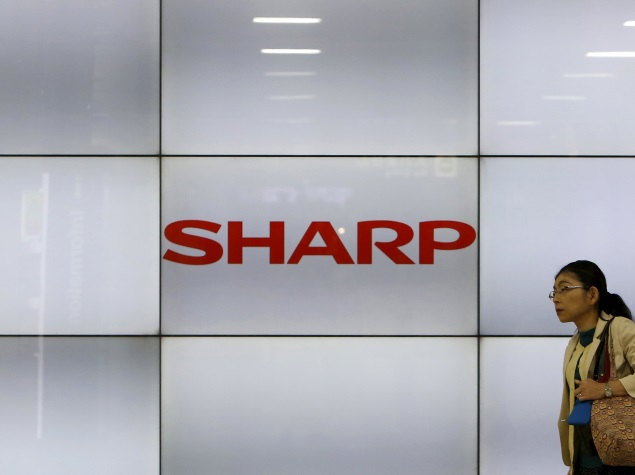- Home
- Mobiles
- Mobiles Features
- Sharp's Decline Marked by Over Confidence, Years of Drift
Sharp's Decline Marked by Over-Confidence, Years of Drift

Within months, however, Sharp found it was sharing Xiaomi revenue as upstart rival Japan Display also struck a deal to supply the Chinese firm with its "in-cell" displays.
It was a pattern repeated over years of drift as Sharp, confident in its technological superiority, found itself blindsided by rivals.
It also struggled to persuade customers to pay a premium for its high-end "IGZO" display technology, which features high resolution and low energy consumption, as rivals quickly out manoeuvred it with competitive technology.
Once among the top display suppliers to Apple Inc, Sharp has been pushed aside by the likes of LG Display and Japan Display, as the U.S. device maker diversified its supply chain amid longstanding concerns over Sharp's prospects.
Critics say Sharp often over-estimated its market position, became complacent and over-invested in manufacturing capacity as liquid crystal display (LCD) prices were tumbling.
Sharp announced on Thursday its second major bail-out in three years, with main lenders Mizuho Bank and Bank of Tokyo-Mitsubishi UFJ injecting a combined JPY 200 billion ($1.7 billion) in a debt-for-equity swap.
CEO Kozo Takahashi acknowledged Sharp had often been slow to pick up on changes. "If we hadn't made mistakes, we wouldn't be here," he said at a news conference. "Our governance and management was weak in terms of catching on to change and reacting as a company."
But he also put some blame on a "rapid deterioration" in the market, and shrugged off calls to consider spinning off the display business.
On Friday, shares in Sharp fell more than 10 percent to their lowest since December 2012. The stock has fallen by around 85 percent in the past 5 years.
Pride before a fall
Analysts say a merger with Japan Display would make sense, but insiders at Sharp - named after a mechanical pencil invented by its founder over a century ago - have scoffed at the idea of a deal with what they consider a lesser player.
Even as the losses grew and debts piled up, and it was clear Sharp would need more help from banks, executives touted the company's proud history.
"Sharp was the first to make radios in Japan and the first to mass produce TVs here ... We want to continue being the kind of company that's at the forefront of change," Chief Technology Officer Shigeaki Mizushima told reporters in January at the Consumer Electronics Show in Las Vegas, where he presented plans for new high-end TVs costing close to JPY 1 million ($8,344).
Sales of TVs fell around 10 percent in the year through March.
The decline at Sharp can be traced back to a decade ago, according to some industry experts, when the company spent hundreds of billions of yen to expand its LCD manufacturing facilities in Kameyama, a rural city in central Japan.
LCD panel prices were already falling by around 30 percent year-on-year at the time, according to market research, but Sharp sought economies of scale to gain an edge over its rivals. It followed later with a JPY 430 billion investment in a new LCD plant in Sakai, near Osaka, which started operating in 2009.
These big outlays, combined with slower-than-expected sales, pushed Sharp to seek a JPY 360 billion bail-out from its banks in 2012. It sold a 38 percent stake in the Sakai plant to Taiwan's Hon Hai Precision Industry Co Ltd that year.
Takahashi is to cut Sharp's global headcount by a tenth and implement reforms to ensure the company responds more swiftly to shifts in the market, but his rejection of more drastic changes such as spinning off parts of the business has left analysts doubting its long-term prospects.
Brokerages downgraded their view on Sharp stock, with Merrill Lynch rating it an 'underperform', and cutting its price target to JPY 60 a share from JPY 260.
© Thomson Reuters 2015
Catch the latest from the Consumer Electronics Show on Gadgets 360, at our CES 2026 hub.
Related Stories
- Samsung Galaxy Unpacked 2025
- ChatGPT
- Redmi Note 14 Pro+
- iPhone 16
- Apple Vision Pro
- Oneplus 12
- OnePlus Nord CE 3 Lite 5G
- iPhone 13
- Xiaomi 14 Pro
- Oppo Find N3
- Tecno Spark Go (2023)
- Realme V30
- Best Phones Under 25000
- Samsung Galaxy S24 Series
- Cryptocurrency
- iQoo 12
- Samsung Galaxy S24 Ultra
- Giottus
- Samsung Galaxy Z Flip 5
- Apple 'Scary Fast'
- Housefull 5
- GoPro Hero 12 Black Review
- Invincible Season 2
- JioGlass
- HD Ready TV
- Laptop Under 50000
- Smartwatch Under 10000
- Latest Mobile Phones
- Compare Phones
- OPPO Reno 15 Pro Max
- Honor Win RT
- Honor Win
- Xiaomi 17 Ultra Leica Edition
- Xiaomi 17 Ultra
- Huawei Nova 15
- Huawei Nova 15 Pro
- Huawei Nova 15 Ultra
- Asus ProArt P16
- MacBook Pro 14-inch (M5, 2025)
- OPPO Pad Air 5
- Huawei MatePad 11.5 (2026)
- Xiaomi Watch 5
- Huawei Watch 10th Anniversary Edition
- Acerpure Nitro Z Series 100-inch QLED TV
- Samsung 43 Inch LED Ultra HD (4K) Smart TV (UA43UE81AFULXL)
- Asus ROG Ally
- Nintendo Switch Lite
- Haier 1.6 Ton 5 Star Inverter Split AC (HSU19G-MZAID5BN-INV)
- Haier 1.6 Ton 5 Star Inverter Split AC (HSU19G-MZAIM5BN-INV)

















